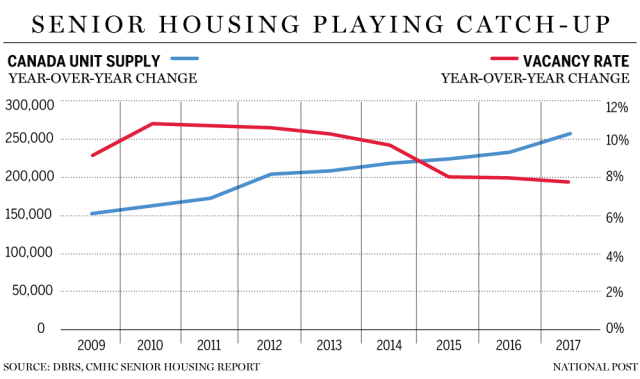Within seven years, the national average for seniors’ home rents could reach $4,000 a month, DBRS report warns
A new cohort is joining young Canadians and others frustrated by sky-high rents and soaring housing costs: seniors.
A looming affordability crisis is poised to hit seniors across the country as the baby boom generation makes its long-predicted shift into its golden years, squeezing the supply of retirement home places and pushing up rents, according to a new report from the rating agency DBRS Ltd.
“For seniors who live on a fixed income or a government pension, they are facing the affordability issue even more,” said Karen Gu, senior vice-president at DBRS and a co-author of the report. “The younger generation at least has the possibility of a regular job and a pay cheque.”
The average rents for seniors’ homes varied across the country in 2017, with Ontario holding the highest at $3,526 per month and Quebec the lowest at $1,678 per month. Should rents continue to grow at the current rate of 4.7 per cent year, the national average could reach just over $4,000 a month by 2025, the report cautions.
The problem comes down to a failure of supply to keep up with demand. By 2026, more than 2.4 million Canadians aged 65 and older will need the “supportive care” offered by retirement homes, including monitoring of medication, regular housekeeping, meal preparation and other services. As more baby boomers turn 65, the number requiring such care is expected to reach “a staggering” 3.3 million by 2046, DBRS found.
More senior housing units are being developed every year, but not enough to meet the anticipated demand. The rate of increase for Canada’s senior population swelled by 21.7 per cent between 2006 and 2016 — more than double the rate of the supply increase.

“It’s not like we didn’t know the baby boomer bulge was coming, we just didn’t do anything about it,” said Laura Tamblyn Watts, national director of law, policy and research at CARP (formerly the Canadian Association of Retired Persons). “There has been a failure across the entire system to prepare.”
Just as rent levels differ across the country, a patchwork of provincial policies means seniors’ ability to absorb them will also diverge, depending on where they live, she said. While British Columbia and Alberta offer subsidies for retirement home costs, Ontario’s retirement homes rely entirely on private payments.
Meanwhile, a shortage of long-term care beds has exacerbated demand for retirement homes, Tamblyn Watts added, as those seniors unable to secure a place in publicly funded facilities choose the next best option.
“The reality is, we need to make investments now.”


 Maziar Moini, Broker of Record - Home Leader Realty Inc.
300 Richmond St. W., #300, Toronto, ON M5V-1X2
Maziar Moini, Broker of Record - Home Leader Realty Inc.
300 Richmond St. W., #300, Toronto, ON M5V-1X2

